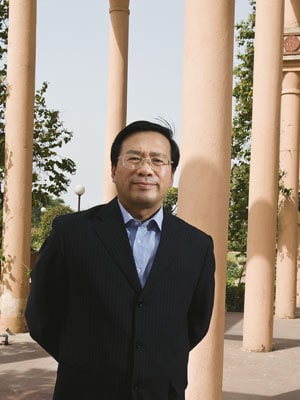
Donít Subsidise Suppliers, Subsidise Consumers
When it comes to poverty alleviation and social security, China often cuts out the middleman and takes the benefits directly to the people. Chinese economist Jun Han talks about the lessons it holds for India
Jun Han
Age: 46 years
Designation: Director General, research department of rural economy, Development Research Centre of the State Council, China
Education: M.A. and Ph.D. in Agriculture Economics from Northwest Agricultural University, China
Career: Vice-president of Chinese Association of Agricultural Economics
Interests: Walking, visiting rural areas and interacting with people
India is in the process of redefining the way it estimates its poverty. What is the Chinese standard?
Actually, poverty reduction in China specifically means poverty reduction in rural areas. The target population is the rural population. The poverty line set by China’s central government is about $200 per year [per capita]. The population below this line is about 36 million. The poverty incidence rate in rural areas is about 4 percent.
In the cities, we have not set the poverty line. Instead, we have the minimum living standards guarantee system. It is decided by the cities themselves. But I can tell you that the total population covered by this urban mechanism is 26 million.
How was China’s strategy to alleviate poverty implemented?
The overall strategy consisted of three major components. The first one is about land tenure. All farmers have access to land and the size of land holdings across the families and communities is largely equal. This happened in the late 1970s. I think the land reforms gave everyone the incentive to raise agricultural productivity, which in turn helped farmers to improve their standard of living.
Second, since the 1980s the government has encouraged the development of Townships and Village Enterprises (TVEs). It is like the non-farm sector in the rural areas. Over the last three decades, the development of TVEs has generated more than 100 million non-farm jobs for farmers.
The third is the deepening of the exposure of the domestic economy to the outside world since the 1990s. By this time many industrial hubs, especially the export-oriented ones, were already well developed. These provided around 50 million job opportunities for the farmers.
In India, there is increasing social and political unrest due to land acquisition for various industrial projects. How did China tackle this tricky issue?
The land acquired between mid 1980s and 1990s annually was about 300,000 to 400,000 hectares. In recent years, the annual acquisition would be around 200,000 hectares. The main difference between India and China on this issue is that the land in China is collectively owned. That means when you conduct the land acquisition the legal barriers are less. For example, last year we brought out an expressway of 4,000 km in length. The length of all the expressways in China is about 70,000 km, next only to the US.
But to be honest, we also face protests from the farmers when land acquisition is conducted. One of the major policies in China is that first of all you have to safeguard the living standard of the farmers whose land is acquired. Second is securing a job for the farmer who is displaced. The third is the housing for the farmers so dislocated. The fourth, which I think is the most important, is provisioning of pension and medical care insurance.
The government ensures all this. Actually, the land acquisition must be done through the government.
What was the reason behind the success of the TVEs?
China, at that time, was basically an economy of scarcity and whatever was produced in the TVEs was absorbed by the huge consumption demand in the urban areas. At that time, the price of land and labour force was very low, making the TVEs very competitive. Another reason was the evolution of township governments and the village communities, which had very strong resource mobilisation capacity to foster the development of TVEs.
How did China tackle corruption in public programmes?
Actually, 10 years ago the leakage problem was also serious in China…which means that various levels of the organisations blocked the money that was meant for the people at the ground level.
But in the last 10 years, we have made many efforts, trying to avoid such leakages. One of the major progress made in this regard is what we call the “direct payment programme” for farmers…or cash transfers in other words. For example, the cash programme includes subsidies when a farmer buys chemical fertilisers or quality seeds or even for rearing livestock.
The central government sets up an individual account for every household and the payment is directly transferred to this account.
In the past, we used to subsidise the suppliers, for example the schools and the hospitals. But now we changed it to directly subsidising the consumers themselves.
So now, if a farmer is involved in the rural medical care system then the government will directly subsidise him by an amount $20 per year. This money goes into the bank account. Similarly, if you are part of the pension system then $10 goes to you account directly.
In education too, instead of subsidising the schools we now have free textbooks for all children.
What do you think about the system of handing out food stamps?
I don’t think the food stamp has been a success story across the world. Only a few countries have been successful.
So we directly pay in cash. For example, when the food price goes up the people [with a] lower standard of living and college students are given the money directly.
Similarly, earlier we used to subsidise training institutes but now we give the money directly to the farmer and let him choose the institute that suits his needs the best. This also promotes competition among the institutes to provide the best training.
(This story appears in the 30 November, -0001 issue of Forbes India. To visit our Archives, click here.)





